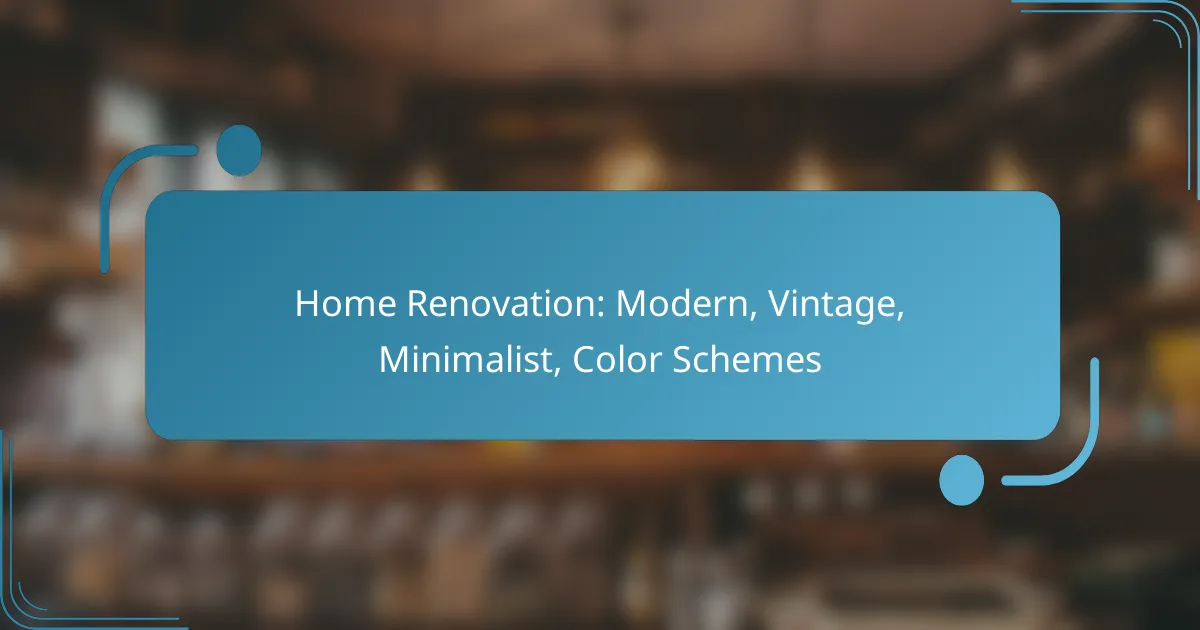Home renovation offers a unique opportunity to blend style and functionality, whether you lean towards modern, vintage, or minimalist designs. Modern renovations prioritize efficiency and aesthetics with open layouts and smart technology, while vintage styles celebrate timeless charm through antique elements and period colors. Minimalism, on the other hand, emphasizes simplicity and tranquility, creating serene spaces with neutral palettes and functional furnishings.

What are the best modern home renovation ideas?
The best modern home renovation ideas focus on enhancing functionality, efficiency, and aesthetics. Key concepts include open-concept layouts, smart technology, energy efficiency, minimalist design, and the use of natural materials.
Open-concept layouts
Open-concept layouts remove barriers between living spaces, creating a seamless flow throughout the home. This design promotes social interaction and maximizes natural light, making spaces feel larger and more inviting.
When considering an open layout, think about how to maintain privacy and acoustics. Use furniture placement and area rugs to define spaces without the need for walls.
Smart home technology integration
Integrating smart home technology enhances convenience and security. Features like smart thermostats, lighting systems, and security cameras can be controlled remotely, improving energy efficiency and peace of mind.
Before installation, assess compatibility with existing systems and consider user-friendliness. Investing in a central hub can streamline control over multiple devices.
Energy-efficient upgrades
Energy-efficient upgrades reduce utility bills and environmental impact. Common improvements include high-efficiency appliances, better insulation, and energy-efficient windows.
Look for products with ENERGY STAR ratings, which indicate superior efficiency. These upgrades often qualify for local rebates or tax incentives, making them financially attractive.
Minimalist design elements
Minimalist design emphasizes simplicity and functionality, focusing on essential elements while eliminating clutter. This approach creates a calming environment and can make small spaces feel larger.
Incorporate minimalist design by choosing furniture with clean lines, neutral colors, and multi-functional pieces. Avoid excessive decor to maintain a serene aesthetic.
Natural materials usage
Using natural materials like wood, stone, and bamboo adds warmth and character to modern renovations. These materials are often more sustainable and can enhance indoor air quality.
Consider sourcing locally to reduce environmental impact and support regional economies. Mixing different textures can create visual interest while maintaining a cohesive look.

How to incorporate vintage styles in home renovation?
Incorporating vintage styles in home renovation involves blending original architectural elements with antique furnishings and period-appropriate color schemes. This approach creates a timeless aesthetic that honors the past while providing modern functionality.
Restoration of original features
Restoring original features is essential for maintaining the vintage character of a home. Focus on elements such as crown molding, hardwood floors, and decorative fireplaces, which can often be refurbished rather than replaced. Ensure that any restoration work adheres to local preservation guidelines, especially in historic districts.
When restoring, consider hiring professionals who specialize in vintage homes to avoid damaging original materials. This investment can significantly enhance the home’s value and appeal.
Use of antique furnishings
Incorporating antique furnishings is a straightforward way to enhance vintage style. Look for pieces from specific eras that resonate with your overall design vision, such as Victorian, Art Deco, or Mid-Century Modern. These items can often be found at estate sales, antique shops, or online marketplaces.
Mixing antique pieces with modern elements can create a balanced look. However, be cautious not to overcrowd spaces; aim for a few standout items that draw attention without overwhelming the room.
Vintage color palettes
Choosing a vintage color palette is crucial for achieving an authentic look. Soft, muted tones like dusty rose, sage green, and buttery yellow are often associated with vintage styles. Consider using these colors on walls, trim, and furnishings to create a cohesive atmosphere.
When selecting paint or fabric, look for options that reflect the era you are emulating. For example, pastel colors are popular in the 1950s, while earthy tones were favored in the 1970s. Testing samples in natural light can help ensure the colors work well together in your space.

What are the key elements of minimalist home renovation?
Minimalist home renovation focuses on simplicity, functionality, and a clean aesthetic. Key elements include neutral color schemes, functional furniture, and decluttered spaces that enhance the overall tranquility of the home.
Neutral color schemes
Neutral color schemes are foundational in minimalist design, creating a calm and cohesive environment. Shades like white, beige, gray, and soft pastels are commonly used to promote a sense of openness and light.
When selecting colors, consider using a palette that includes varying tones of the same hue to add depth without overwhelming the space. For instance, pairing light gray walls with darker gray furniture can maintain a minimalist look while adding visual interest.
Functional furniture
Functional furniture is essential in minimalist renovations, emphasizing practicality without sacrificing style. Choose pieces that serve multiple purposes, such as a sofa bed or a coffee table with storage.
Look for furniture with clean lines and simple forms, avoiding ornate designs that can clutter the visual space. Materials like wood, metal, and glass are often preferred for their durability and sleek appearance.
Decluttered spaces
Decluttered spaces are a hallmark of minimalist design, promoting a serene atmosphere. This involves reducing excess items and organizing belongings to ensure that only essential items are visible.
To achieve a decluttered look, regularly assess your possessions and consider donating or discarding items that no longer serve a purpose. Implement storage solutions that keep items out of sight, such as built-in cabinets or under-bed storage, to maintain a clean and open environment.

How to choose the right color schemes for renovations?
Choosing the right color schemes for renovations involves understanding the emotional impact of colors and how they can enhance the functionality of each space. Consider both current trends and the specific atmosphere you want to create in your home.
Understanding color psychology
Color psychology explores how different colors affect mood and behavior. For example, blues and greens are often calming and can create a serene environment, making them suitable for bedrooms or bathrooms. In contrast, warm colors like reds and oranges can energize a space, ideal for kitchens or dining areas.
When selecting colors, think about the feelings you want to evoke. Neutral tones can provide a versatile backdrop, while bold colors can serve as accents to draw attention to specific features or artwork.
Popular color trends for 2023
In 2023, earthy tones such as terracotta, sage green, and muted yellows are gaining popularity, reflecting a desire for connection to nature. These colors can create a warm and inviting atmosphere, perfect for living spaces.
Additionally, soft pastels and monochromatic palettes are trending, offering a minimalist aesthetic that can make spaces feel larger and more cohesive. Consider incorporating these trends into your renovation plans to stay current and enhance your home’s appeal.
Choosing colors based on room function
When selecting colors for different rooms, consider the function of each space. For example, soft blues and greens work well in bedrooms for relaxation, while bright yellows can stimulate creativity in home offices.
In high-traffic areas like hallways or living rooms, durable and easy-to-clean paint finishes are advisable. Opt for colors that can withstand wear and tear while maintaining a welcoming atmosphere. Always test paint samples in the actual space to see how lighting affects the color throughout the day.

What are the costs associated with home renovation?
The costs associated with home renovation can vary widely based on the scope of the project, materials used, and labor costs. Homeowners should expect to budget for both direct expenses like construction and indirect costs such as permits and design fees.
Average renovation costs per square foot
On average, home renovation costs range from approximately $100 to $300 per square foot, depending on the complexity and quality of materials. For example, a basic kitchen remodel may cost around $150 per square foot, while a high-end bathroom renovation could reach $250 or more.
Regional variations also play a significant role; urban areas typically have higher costs due to labor and material demand. It’s essential to obtain multiple quotes to gauge local pricing accurately.
Factors affecting renovation pricing
Labor costs can vary based on the contractor’s experience and local market rates. Additionally, obtaining necessary permits can add to the overall budget, especially in areas with strict building regulations.
Budgeting tips for homeowners
To effectively budget for a home renovation, start by determining a realistic overall budget that includes a contingency of around 10-20% for unexpected expenses. Prioritize essential renovations to ensure that funds are allocated where they are most needed.
Consider breaking the project into phases to spread costs over time. Researching materials and labor options in advance can also help identify potential savings. Always keep track of expenses to avoid overspending and ensure the project stays on track.

What are the prerequisites for a successful renovation?
Successful renovation requires careful planning, budgeting, and understanding the scope of work. Establishing clear goals and timelines will help ensure that the project stays on track and within budget.
Assessing structural integrity
Assessing structural integrity is crucial before starting any renovation. This involves evaluating the condition of walls, foundations, roofs, and other load-bearing elements to ensure they can support the intended changes.
Begin by inspecting visible areas for cracks, water damage, or signs of pest infestations. If necessary, consult a structural engineer to conduct a thorough assessment, especially for older homes or significant renovations.
Consider the costs associated with repairs or reinforcements. Addressing structural issues early can prevent costly setbacks later in the renovation process. Always prioritize safety and compliance with local building codes to avoid legal complications.







